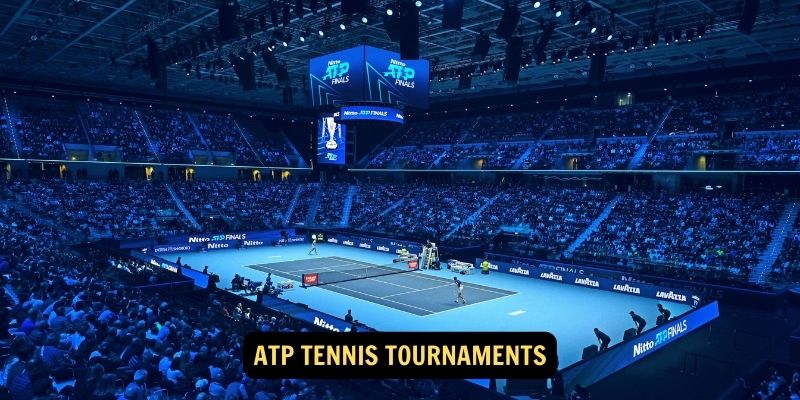The Association of Tennis Professionals (ATP) is the governing body for men’s professional tennis, shaping the landscape of the sport and captivating audiences globally. It represents over 1,600 professional male tennis players from over 90 countries, coordinating tournaments, managing rankings, and promoting the game at all levels. The ATP Tennis Tour features a diverse array of events, ranging from smaller Challenger tournaments to prestigious Grand Slams, all contributing to a thrilling competitive landscape. Each year, players compete for points, vying for coveted rankings and the opportunity to claim the coveted year-end No. 1 position. Let’s explore more with 82lottery.
History of ATP Tennis

The Birth of Player Autonomy
The story of ATP tennis begins in 1972, when a group of players, led by legendary names like Rod Laver and Ken Rosewall, spearheaded a movement for independence and self-governance. They sought more control over their profession, challenging the existing dominance of the International Lawn Tennis Federation (ILTF). This pivotal moment marked the birth of the ATP, ushering in a new era of player empowerment and professionalization.
| Year | Key Event |
| 1972 | A group of players, led by Rod Laver and Ken Rosewall, create the ATP Tennis to challenge the ILTF’s control over professional tennis. |
| 1973 | The first ATP Tennis Tour is launched, featuring a circuit of professional tournaments. |
| 1980s | The ATP Tennis Tour gains popularity, with charismatic players like Bjorn Borg, John McEnroe, and Jimmy Connors captivating global audiences. |
| 1990s | The ATP Tennis continues to evolve, introducing the ATP Masters 1000 events to enhance the competitive landscape. |
| 2000s-present | The Big Three (Roger Federer, Rafael Nadal, and Novak Djokovic) dominate the sport, setting new benchmarks for excellence. |
The Rise of the ATP Tennis Tour
The creation of the ATP Tour, a circuit of professional tournaments, provided players with a platform to showcase their skills, compete for lucrative prize money, and earn the respect and adoration of fans worldwide. The ATP’s early years saw a surge in popularity, fueled by charismatic players like Bjorn Borg, John McEnroe, and Jimmy Connors, who captivated the world with their extraordinary talent and fierce competitive spirit. Their rivalries transcended the court, reaching global audiences and solidifying tennis’s place as a global entertainment phenomenon.
- The establishment of the ATP Tour in 1973 marked a significant milestone in the history of professional tennis.
- The tour provided players with a structured and organized platform to compete, earn income, and build their careers.
- Legendary players like Borg, McEnroe, and Connors helped drive the popularity of the ATP Tour, captivating fans with their on-court rivalries and compelling personalities.
Embracing Innovation and Expansion
Over the decades, ATP tennis has continued to evolve, embracing innovation and expanding its reach. The introduction of ATP Masters 1000 events, prestigious tournaments held in major cities worldwide, further enhanced the competitive landscape and added another layer of prestige to the professional circuit. These events, along with the prestigious Grand Slam tournaments, have become the pinnacle of the ATP Tour, drawing the world’s best players and captivating global audiences.
Top ATP Tennis Players

The history of ATP tennis is rich with legendary names who have left an indelible mark on the sport. Players like Roger Federer, Rafael Nadal, and Novak Djokovic, collectively known as the Big Three, have dominated the game for over a decade, setting new benchmarks for excellence and breaking countless records. Their unmatched talent, athleticism, and fierce rivalry have elevated the game to new heights, captivating fans worldwide.
The Big Three
- Roger Federer: Known for his elegant style and unmatched finesse, Federer has captured 20 Grand Slam titles, establishing himself as one of the greatest players of all time.
- Rafael Nadal: With his ferocious groundstrokes and unwavering determination, Nadal has won an astounding 22 Grand Slam titles, including a record 14 French Open victories.
- Novak Djokovic: Renowned for his exceptional return of serve and relentless mental fortitude, Djokovic has surpassed both Federer and Nadal in Grand Slam victories, achieving a historic 23 titles.
Emerging Talents
The current ATP landscape is a dynamic and competitive one, featuring a new generation of talented players who are pushing the limits and challenging the established order. Daniil Medvedev, with his impressive athleticism and aggressive playing style, captured the US Open title in 2021. Carlos Alcaraz, a young Spanish prodigy, has already captured a Grand Slam title, winning the US Open in 2022, and is currently ranked No. 1 in the world.
- Daniil Medvedev: A rising star on the ATP Tour, Medvedev’s powerful and unorthodox style of play has led him to Grand Slam success, including winning the 2021 US Open.
- Carlos Alcaraz: The young Spanish sensation has already made a significant impact, winning the 2022 US Open and becoming the youngest player to reach the world No. 1 ranking.
ATP Tennis Tournaments

The ATP Tour comprises a wide array of tournaments, each adding its own flavor to the game and providing players with varied challenges. At the pinnacle of the sport stand the four Grand Slam events: the Australian Open, French Open, Wimbledon, and US Open. These prestigious tournaments hold a special significance, attracting the world’s best players and captivating global audiences.
Grand Slam Events
- The Australian Open, French Open, Wimbledon, and US Open are the four Grand Slam tournaments on the ATP Tour.
- These events are the most prestigious and prestigious in professional tennis, attracting the top players in the world and offering the highest prize money and ranking points.
- Grand Slam tournaments are renowned for their unique playing surfaces, traditions, and the intense competition they provide.
ATP Masters 1000 Events
The ATP Masters 1000 series, held in major metropolitan centers like Indian Wells, Miami, Monte Carlo, and Madrid, provides players with a platform to compete against the best, earn significant ranking points, and prepare for Grand Slam events. These events also feature larger prize pools, adding to their prestige and importance in the ATP calendar.
- The ATP Masters 1000 events are the second-highest tier of tournaments on the ATP Tour, after the Grand Slams.
- These tournaments are held in iconic locations around the world and attract the top-ranked players on the tour.
- Masters 1000 events offer substantial ranking points and prize money, making them crucial events for players to compete in and perform well.
Other ATP Tournaments
Beyond the Grand Slams and Masters 1000 events, the ATP Tour offers a range of other tournaments, including the ATP 500 and 250 series, providing players with opportunities to gain valuable ranking points and test their skills against a variety of opponents.
- ATP 500 tournaments: These events offer a high level of competition and ranking points, with a focus on attracting top-ranked players.
- ATP 250 tournaments: These smaller-scale events provide opportunities for players to earn points and gain valuable experience on the professional circuit.
- Challenger tournaments: The Challenger Tour serves as a stepping stone for young and aspiring players, offering them a chance to compete and climb the ATP rankings.
ATP Tennis Rankings
The ATP rankings play a crucial role in shaping the landscape of professional tennis, determining player seedings in tournaments, entry into prestigious events, and ultimately, a player’s standing in the world of tennis. Players earn points for winning matches at ATP tournaments, with the value of points increasing as the tournament level rises.
Earning Ranking Points
- Grand Slam events award the highest number of ranking points, followed by ATP Masters 1000, ATP 500, and ATP 250 tournaments.
- Challenger tournaments offer a lower number of points, but they provide an important pathway for young and emerging players.
- Players accumulate points based on their performance in these events, with the top-ranked players earning the most points.
The Importance of Rankings
- A player’s ranking determines their seeding in tournaments, which can significantly impact their draw and path to the finals.
- Higher-ranked players have increased opportunities to compete in the most prestigious events, such as Grand Slams and Masters 1000 tournaments.
- Rankings also influence a player’s earning potential, as they can secure more lucrative sponsorship deals and prize money based on their standing.
Ranking Updates and Calculations
- ATP rankings are updated every Monday, reflecting the latest tournament results.
- The rankings are calculated based on a player’s performance over a rolling 52-week period, with older results gradually decreasing in value.
- This system ensures that the rankings accurately reflect a player’s current form and ability, providing a fair and objective measure of their standing in the sport.
Future of ATP Tennis
ATP tennis is in a constant state of evolution, shaped by technological advancements, changing player demographics, and evolving fan preferences. As the sport continues to progress, several key factors will influence its future trajectory.
Technological Advancements
- The use of technology is already transforming the sport, improving player performance analysis, enhancing broadcasting, and providing fans with immersive experiences.
- Data analytics and artificial intelligence are being leveraged to enhance coaching strategies, player development, and fan engagement.
- The integration of cutting-edge technologies, such as advanced sensor systems and augmented reality, will continue to push the boundaries of the sport.
Diversifying Player Profiles
- The rise of new talent from diverse nations and continents is injecting new energy and dynamic playing styles into the game.
- Players with diverse backgrounds and cultural influences are challenging the established order, bringing fresh perspectives and broadening the global reach of the sport.
- This influx of talent from around the world will continue to shape the competitive landscape and captivate audiences.
Addressing Challenges
- The ATP will face challenges in the years to come, including the ongoing battle for fan attention in a digital world.
- The need to address player burnout concerns and the growing importance of balancing traditional values with innovation will be crucial.
- Adapting to changing fan preferences and maintaining the sport’s relevance in an ever-evolving entertainment landscape will be a key priority.
Despite these challenges, the ATP is poised to overcome them and continue to thrive in the years to come. With its adaptability, commitment to promoting the game, and the unwavering passion of players and fans, ATP tennis will undoubtedly remain a prominent force in the world of sports, inspiring generations to come.
Conclusion
The Association of Tennis Professionals (ATP) has played a pivotal role in shaping the landscape of professional men’s tennis. From its humble beginnings as a player-driven movement for independence to its current status as a global governing body, the ATP has consistently evolved, embracing innovation and expanding its reach. The ATP Tour has become a platform for some of the greatest tennis players to showcase their skills, captivating audiences worldwide.
As the sport continues to evolve, the ATP faces new challenges and opportunities. However, with its adaptability, commitment to player development, and the enduring passion of fans, the ATP is poised to overcome these obstacles and solidify its position as the premier governing body for men’s professional tennis. The future of ATP tennis looks bright, with the promise of continued excellence, the emergence of new talents, and the ongoing pursuit of greatness that has defined the sport for generations.
